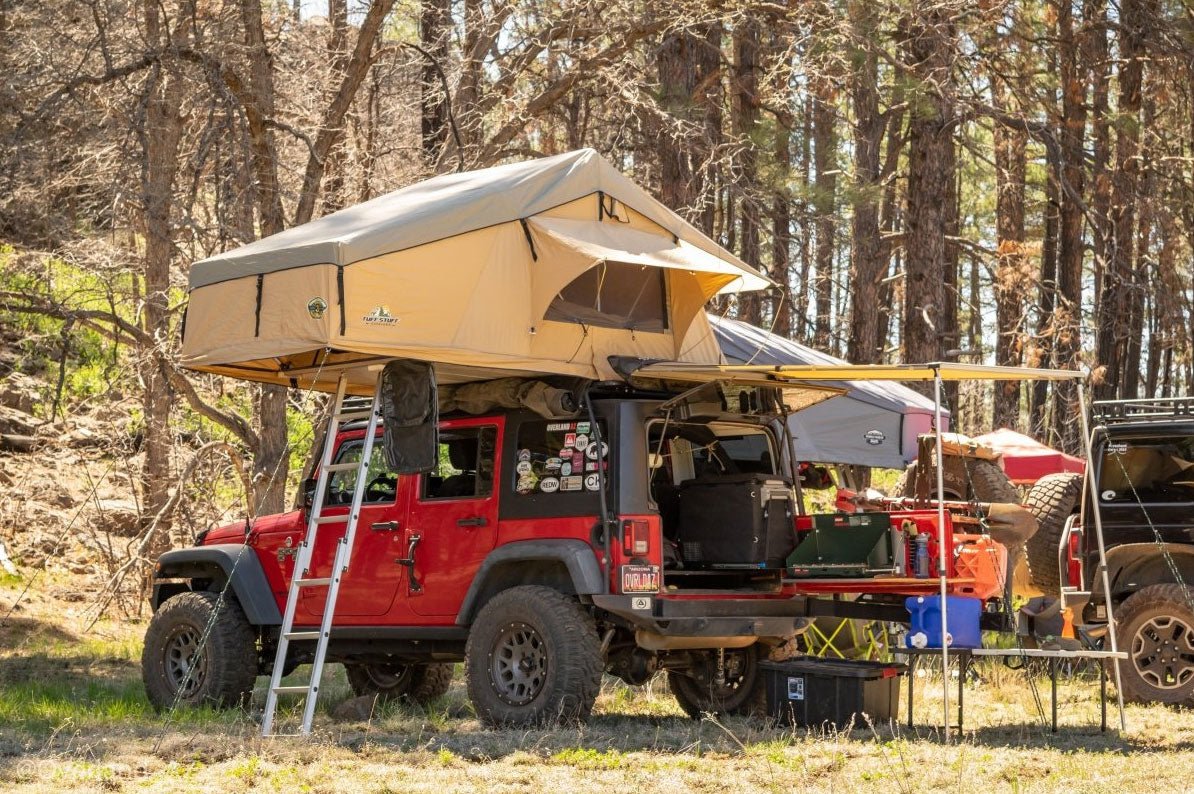If the beach, mountain views, and tall trees are your vibe, you will enjoy overland camping in Texas. With its diverse landscapes and scenic views, Texas offers different terrains for overland campers to enjoy their explorations and have an adventure they will never forget.
Will you like to explore the numerous overland terrains in Texas on your subsequent overland camping trip? We have prepared a list of overland camping spots in Texas waiting to be explored.

Overlanding In Texas
Texas is a state in the South Central region of the United States. Known as the Lone Star State, Texas measures 268,596 square miles and is the second-largest state in the United States of America.
With its large size and vast expanse of land, it is easy to see why anyone will think there are many overland trails and camping spaces in Texas, but that is not the case. Texas might have an immense size, but thanks to the lack of public lands, which is a result of generations of private ranching, farming, and oil extraction, there are not a lot of places you can visit for overland camping.
Regardless of this, there are still some areas overland campers are permitted to visit. There are various landscapes, and although the list is not extensive, you can still have a great time on your overland trip.
Texas is not only known for its infamously hot weather, diverse culture, or delicious barbeque. Besides these fantastic things, Texas is known for being home to stunning landscapes and breathtaking scenery. From the beach to intimidating mountains with lofty peaks, there are different terrains that suit your vibe and overland camping objective.
If you are planning to visit Texas for the first time for a solo overland trip or a group trip with your family or friends, Texas is an ideal location to choose. Although there are not so many locations to choose from, you will still be treated to picturesque sceneries and an experience you won’t forget in a hurry.
Although private bodies own the majority of the Texas land mass, the handful of public lands are overland-camping-friendly and are open for off-roading uses. Each location has different terrain, a variety of landscapes, and ecosystems to explore.
In 2006, the Texas Off-Highway Vehicle (OHV) Program was created to set aside safe and legal places for people to enjoy off-roading. The roads, routes, and trails were developed for the sole purpose of overland campers testing their rigs.
The development of this program encouraged overland campers and off-roaders to explore Texas and encounter nature in Texas in a way they haven’t. However, to gain access to these legal areas, the drivers are required to purchase a decal for their vehicle. The revenue earned from the sales of these decals is pooled to maintain the off-roading routes and create new ones.
Some areas where overland camping is legal are National and State Parks. These parks can be accessed quickly, are pretty maintained, and offer a vast expanse of landscape you can explore.
What Do You Need To Go Overland Camping In Texas?
Like any other camping trip, you must be prepared for overland camping in Texas. However, overland camping is different from your essential camping trip.
Overland camping, also known as overlanding, merges off-roading with camping. It is a self-sufficient and vehicle-based journey where the experience is in the journey itself, and the focus is not on the destination but on the exploits the campers make during the travel.
Overland camping is a journey of self-reliance, resilience, and a focus on experiencing nature at its finest. On an overland camping trip, the camper will be pushed to their wit’s end and fuelled by their determination to see the journey through. Sounds terrific, right?
If you are into this, being prepared should be a priority.
Since overlanding is a vehicle dependent journey, you obviously need to own an overland vehicle. But not just any car will do. We recommend four-wheel drives with high clearance as they will be able to handle any terrain you pick, especially if you plan to visit Texas and its diverse topography.
For your overland trip to Texas, you will also need essential overland camping gear. However, since an overland trip is much longer than a regular weekend camping trip, you must pack long-term while maximizing your space. This might sound like trying to fit an elephant in a rabbit hole but packing for an overland trip is easy if you know what you are doing.
When packing, you need to consider the duration of your trip, the location, and the season and pack accordingly. Always opt for multi-tools, equipment with smaller sizes, and compressible or foldable gear. It would be best if you also mapped out your sleeping arrangement (will you rather sleep in the car, in a standard tent, or a rooftop tent?), pack enough food and water, and other tools like your car safety and recovery gear and first aid supplies.
Since most of these off-roading and overland camping roads are far from civilization, you must be prepared for the worst. Ensure you have the necessary safety, navigation, and communications in case of unplanned events. On any overlanding trip, it is better to be safe than sorry.
After you figure out your items, the next step is to purchase an off-roading decal to gain access to the public lands. When you are fully prepared, the next option is to pick a location to visit.
The Best Overlanding Camping Spots In Texas
To ease the save you from having to research the best spots in Texas for your subsequent overland camping trip, we have compiled a list of safe and legal places to live out your overlanding dreams legally. Get your rigs, and let’s go!
1. Barnwell Recreation Area
Barnwell Recreation Area is located at the top of the Barnwell Mountains in East Texas. It is a property of the Texas Motorized Trails Coalition, dedicated to offering dirt bikes, off-highway vehicles, and utility terrain vehicles on 1,850 acres of land to explore.
Barnwell Recreation Area provides more than 27 miles of challenging single-track trails for riders looking for a demanding albeit safe adventure. There are also about 16 miles of more accessible trails if you are interested in less taxing fun.
In Barnwell Recreation Area, you will find everything from deep trails to steep hills and moderately leveled roads. The courses are well-organized and marked to make them easy to find and follow. Since the trails range from easy to somewhat tricky, you can always pick what works for you.
Barnwell Recreation Area also provides cabins for accommodation. The area has six cabins and five bunkhouses on-site and is in excellent condition. There is also an electric RV camping area with 18 sites and a premium Rv campground with eight sites and a higher amp rating.
To secure accommodation, you need to place a reservation in advance. To enter the park, you need to arrive at open hours. The park office opens from 12 pm to 10 pm on Thursdays, and 8 am to 12 am on Fridays and Saturdays. These times are fixed unless on holidays and in the occurrence of special events.
Essentially, Barnwell Recreation Area is an excellent area to have fun, sight-see, and live your overlanding dreams to the fullest.
2. Crystal Beach
Bolivia Peninsula is a barrier island along the Texas Gulf Coast. It isn’t a uniform strip of land, with its narrowest part being a mile wide and its widest point three miles wide. Bolivia Peninsula separates the eastern part of Galveston Bay from the Gulf of Mexico.
Crystal Beach is located on the Bolivia Peninsula and stretches for about 25 miles of shoreline on the beach. When you choose to explore Crystal Beach, you will be driving directly along the gulf coast, have the option to visit the lighthouse, and even do a little birdwatching at the Shorebird Sanctuary. Sounds dreamy, right?
However, before packing up, hurry to Crystal Beach, ensure your vehicle can handle the moderately rugged sandy terrain and not compromise your safety. At Crystal Beach, you can camp at the Crystal Beach Washout.
3. Texas Hill Country Route
Located near Fredericksburg in southwestern, central Texas, the Texas Hill Country Route offers a topography of hills, mesas, valley, and dirt roads spotted with oaks. It is a naturally charming area with an almost postcard-like beauty that offers scenic views.
Also called the THC Trail, the almost quaint route offers more than 148 miles of dirt roads, gravel roads, and pavement over a vast expanse of land that seems to stretch forever. Although there are many tracks to explore, there is a main and famous road often used by overland campers and many other tourists.
Traveling the Texas Hill Scenic Route ranges from easy to moderately difficult. The roads are not precisely rough and complex, but there are several creeks to cross, so having a 4WD with high clearance is a way to guarantee that you will get across quickly. The rivers and creeks are not that deep, and all measure below 18 inches.
Overland campers can easily travel the THC Trail in two to three days, but to make the most of the environment and explore the surroundings while you are there, you may want to slow down and spend an extra day or two.
If you are not a fan of crowded routes, there are alternative roads you can use like the Llano River Loop and the Junction Extension. Some of these alternative trails connect via paved roads and pavements.
When traveling the Texas Hill Country Route, remember that private lands surround the area, so be mindful of the routes and paths you take and choose to camp on to avoid trespassing.

4. Black Gap Road
Located on Big Bend Road is an overlanding trail that puts any overland camper’s driving skill to the test. It is a popular 16.2-mile out-and-back trail considered moderately challenging.
When overland campers aren’t using it, the Black Gap Road is used by hikers and horseback riders. It is a scenic route which explains its popularity. However, as beautiful as the area is, the gravel dirt road is covered in sharp rocks, steep parts, and washboards. To conquer this trail, you should drive a 4WD with good ground clearance.
Black Gap Road runs from Glens Springs Road to Talley Road. It is a desert and can be hot most of the year.
When driving on Black Gap Road, you get a nice view of the Chisos Mountains with their lofty peaks and the Chihuahuan desert below. Black Gap Road received the Badge of Honor award from Jeep, and it is easy to see why.
5. Mustang Island Beaches
Mustang Island Beaches is another fantastic overland camping spot in Texas. It is a sandy trail located in the Mustang Island State Park.
The state park is a hotspot for many fun activities like swimming, camping, picnics, kayaking, and birdwatching, especially during the spring and fall migration. It features lots of camping areas and includes 48 water and electric campsites and 50 drive-up dispersed campsites. At this park, there are a lot of accommodation options that suit your needs.
The Mustang Island Beach stretches for over 13 miles with a sandy terrain that is easy to maneuver. You can take time off from your driving to appreciate the sand, water, and sun and to have fun in neighboring areas like Corpus Christi and Port Aransas.
The Mustang Island State Park opens from 8 am to 5 pm every day. To gain access, you will be required to pay $5 for adults, while children under 12 enjoy free entrance. However, given the experiences that await you inside the park, $5 is a small price.
6. River Road
River Road is another overland camping spot in Big Bend National Park. It transverses the small southern portion of the park, connecting the areas near Rio Grande Village and Castolon.
Although it is called the River Road, you cannot view the river while driving along the road. If you want to see the river, you will have to break off your trip and go to one of the dispersed campsites near the river.
River Road is 51 miles long and moderately challenging to drive through. You will need a high clearance 4WD with at least 15-inch tire rims to make the journey. The west side of River Road is in rougher condition, so unless you consciously challenge your driving skills, you should enter through Glenn Springs Road. Be careful as this road can easily become washed out when it rains.
There are dispersed campsites by the road where you can set up camp, but to do so, you will need a permit.
7. Old Ore OHV Road
The Old Ore OHV Road is another overlanding spot in the Big Bend National Park. It is a 26.5-mile long route of moderately challenging overlanding road.
Although the Old Ore OHV Road is famous for its off-road driving paths, it is equally known for being an excellent place for horseback riding. The beautiful trail is open year-round which might explain why it is an overland-camper favorite.
Old Ore Road was used to transport ore from the Mexican mines in the 1900s. Now, the Old Ore OHV Road is rough, rocky, and requires overland campers who aim to visit to have a high-clearance 4WD.
If you manage to conquer the challenging routes, you will be treated to a breath-taking view of the Chisos Mountains. Old Ore Road has 11 primitive roadside campsites you can retreat to.
8. Paint Gap Road
Although you require a fee to gain access to Paint Gap Road, the 12.2-km out-and-back trail near Big Bend National Park is worth every cent. Paint Gap Road might seem like an unassuming dirt road in its first 2.5km kilometer drive, but after that, visitors are treated to a challenging drive on a rocky road. This is an excellent way to enjoy a drive that puts your driving to the test.
The drive through Paint Gap Road takes about two and a half hours to complete. There are four primitive camping grounds that you can enjoy at the site.
Experiencing Nature In Texas
Although the list of over landing spots in Texas is not excessively long, each site on the list promises an overland camping experience you will not forget in a hurry. The different terrains, topography, and landscapes provide unique experiences and each experience in one spot is different from the next.
All-in-all, every overland camper needs to visit an overland camping spot in Texas at least once in their lifetime and experience nature in the Lone Star State.



